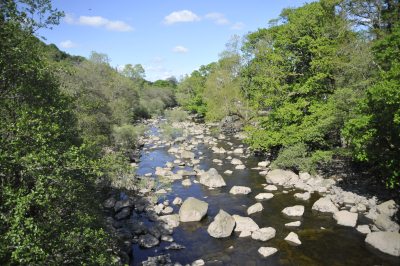Elan Valley Reservoirs

|
Elan Valley Reservoirs
The beautiful Elan Valley Reservoirs are a chain of man-made lakes and reservoirs in the Elan Valley, Powys, Mid Wales, - "The Welsh Lake District", using the rivers Elan and Claerwen. The reservoirs are Claerwen, Craig Goch, Pen-y-Garreg, Garreg Ddu and Caban Coch, the one we visited a couple of miles from our hotel and the red kite feeding station.
Our little hire car which kept us safe for the 1721 miles we did in the UK and a friend sheltering from the hill winds The
work carried out over a hundred years ago to build the Elan Valley dams and
reservoirs was only part of the huge undertaking. Almost as impressive was the
challenge of delivering the enormous quantities of water by gravity alone,
across very hilly country and over many river valleys, to the new Frankley
Reservoir
on the outskirts of Birmingham.
This involved building the seventy three mile long Elan Aqueduct,
down which the water travels at less than two miles per hour, taking one and a
half days to get to Birmingham. It
runs from the Elan Valley to Frankley
in Birmingham. There are several signs of the aqueduct between these points, in
the form of brick aqueducts, exposed pipelines and red brick valve houses on
hillsides. Birmingham's
tap water is noted for being exceptionally soft, with a low percentage of
dissolved minerals. There are four main dams and reservoirs (constructed 1893–1904 in Elan Valley, and 1946–1952 at Claerwen) with a potential total capacity of nearly 100,000 megalitres. The dams and reservoirs are:

In
addition to the four main dams, there are three other dams at the
site:
 The wind that came down the valley over
the water was breathtaking
  The hills behind the dam showing Bear
limping along, were incredibly steep
History
The
reservoirs
were constructed between 1893 and 1904 by the City of Birmingham's Water
Department
to supply clean water
to the Birmingham
area, by gravity
feed along the Elan Aqueduct
with a gradient
of 1 in 2,300, that is a drop of only fifty two metres over the length of
seventy three miles. Before
the construction of the dams, the standard gauge Elan Valley Railway
was built to all dam
sites from a junction of the Mid Wales Railway, at Rhayader.
The railway
was also built along the dams themselves at varying heights, on wooden
scaffolding supported by concrete parapets. The railway itself went as far as
the never-completed Dolymynach dam (lower down the valley from the later
Claerwen
dam), which had to be built concurrently with the Elan dams as the Caban Coch
reservoir would otherwise have flooded this construction site. However, this
railway was never subsequently needed, and road transport only was used for
construction of the Claerwen dam over forty years later. The construction workers lived in a village of wooden huts, which had a guard to prevent the illegal importing of liquor. This later became the permanent Elan Village. When construction of the dams was complete, most of the workers moved on to the Derwent Valley in Derbyshire. The scheme was opened by King Edward VII and Queen Alexandra on the 21st of July 1904.
World
War II They played an important role in World War II when the 35 foot high Nant-y-Gro dam was used by Barnes Wallis to test his idea of detonating explosives against a dam wall in order to breach it. These experiments culminated in the Dambusters - great movie - breaching of the dams in the Ruhr Valley. The remains of the breached Nant-y-Gro dam can still be seen today in the same state as it was left in 1942. The dam is now partially obscured by trees, but its location is marked by an interpretative plaque. The Derwent Dam was also used by the Dambusters for practice, though it was not breached. After the Dambuster Raid steel cables were placed across Caban Coch reservoir to prevent enemy seaplanes landing on the lake.
Aborted
expansion scheme In the early 1970's it was proposed that the Craig Goch reservoir should be substantially increased in size with a new and higher downstream dam together with another dam to the North-West, impounding water that would otherwise have flowed down the Ystwyth valley. This scheme would have created a huge reservoir dwarfing all others in Mid Wales, and flooding miles of wild upland valleys. The proposals were eventually abandoned in the face of reducing projections for industrial water demand and an increasing awareness of the environmental issues that such an expansion might create.
The Shelley statue by the Visitor's Centre at Caban Coch Dam The
reservoirs today The reservoirs are now owned by Dwr Cymru Welsh Water. Although the filtration works further down the valley is run by Severn Trent Water. A scale model of the reservoir network, in the form of ornamental ponds, is in Cannon Hill Park in Birmingham.
 
In
popular culture
 Caban Coch seen in all its glory
ALL IN ALL SUCH A STUNNINGLY BEAUTIFUL AREA TO
VISIT |










